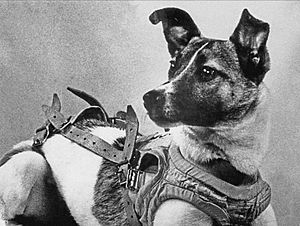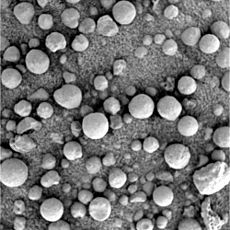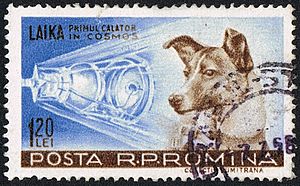Laika facts for kids

Laika in a flight harness
|
|
| Other name(s) | Kudryavka (Кудрявка, "Curly") |
|---|---|
| Species | Canis familiaris |
| Breed | Mongrel, possibly part-husky (or part-Samoyed) and part-terrier |
| Sex | Female |
| Born | Laika (Лайка) c. 1954 Moscow, Soviet Union |
| Died | 3 November 1957 (aged 2–3) Sputnik 2, in Low Earth orbit |
| Known for | First animal to orbit Earth |
| Owner | Soviet space program |
| Weight | 5 kg (11 lb) |
Laika (born around 1954 – died 3 November 1957) was a Soviet space dog. She was one of the first animals in space and the very first to orbit Earth. Laika was a stray mongrel dog found on the streets of Moscow. She flew aboard the Sputnik 2 spacecraft, which launched into low orbit on 3 November 1957.
At that time, scientists didn't know much about how spaceflight would affect living things. Sending animals into space was seen as a necessary step before sending humans. Laika's mission aimed to prove that a living creature could survive being launched into orbit. It also showed that an animal could live in weakened gravity and increased radiation. This experiment gave scientists some of the first information about how space affects living bodies.
Laika died within hours of the flight from overheating. This was likely caused by a problem with the rocket's separation. The real reason and time of her death were not made public until 2002. Before that, it was widely reported that she died when her oxygen ran out on day six. In 2008, a small monument showing Laika on top of a rocket was put up in Moscow. She is also on the Monument to the Conquerors of Space in Moscow.
Contents
The Sputnik 2 Mission
After the successful launch of Sputnik 1 in October 1957, Nikita Khrushchev, the Soviet leader, wanted another spacecraft launched quickly. He wanted it ready by 7 November 1957, for an important anniversary. A more advanced satellite was already being built, but it wouldn't be ready until December. This later became Sputnik 3.
To meet the November deadline, a new spacecraft had to be built very fast. Khrushchev wanted a "space spectacular" to show the world how powerful the Soviet Union was. Planners decided to send a dog into orbit. Soviet engineers had planned to send a dog into orbit before humans. Since 1951, they had already sent twelve dogs on shorter, sub-orbital flights. To meet Khrushchev's demands, they sped up the plan for an orbital dog flight.
The official decision to launch Sputnik 2 was made in mid-October. This left less than four weeks to design and build the spacecraft. Because of the rush, most parts of Sputnik 2 were built from quick sketches. Besides carrying a living passenger, Sputnik 2 also had tools to measure solar irradiance (sunlight) and cosmic rays.
The spacecraft had a special system to keep Laika alive. This included an oxygen generator and devices to prevent oxygen poisoning. It also had tools to absorb carbon dioxide. A fan was added to keep the dog cool, turning on if the cabin temperature went above 15 °C (59 °F). There was enough food for a seven-day flight. Laika wore a special harness and a bag to collect waste. Chains limited her movement to standing, sitting, or lying down, as there was no room to turn around. An electrocardiogram monitored her heart rate. Other tools tracked her breathing, blood pressure, and movements.
Laika's Training and Selection
Laika was found as a stray dog wandering the streets of Moscow. This was just a week before the launch. Soviet scientists chose Moscow strays because they thought these dogs were already used to extreme cold and hunger. Laika was a 5 kg (11 lb) mongrel female, about three years old.
Soviet staff gave her several names. These included Kudryavka (meaning Little Curly), Zhuchka (Little Bug), and Limonchik (Little Lemon). The name Laika, which is Russian for several dog breeds similar to the husky, became famous worldwide. It means "Barker" from the Russian word for "to bark." Some stories say technicians renamed her Laika because she barked a lot. American newspapers called her Muttnik, a pun on Sputnik, or sometimes Curly. Her exact breed is unknown, but she was likely part husky or another Nordic breed, and possibly part terrier. NASA calls Laika a "part-Samoyed terrier." A Russian magazine described her as calm and not fighting with other dogs.
Before this mission, both the Soviet Union and the United States had only sent animals on sub-orbital flights. Three dogs were trained for the Sputnik 2 flight: Albina, Mushka, and Laika. Soviet space scientists Vladimir Yazdovsky and Oleg Gazenko trained the dogs.
To help the dogs get used to the small cabin of Sputnik 2, they were kept in smaller and smaller cages for up to twenty days. This close confinement made them restless and caused their health to worsen. Researchers found that only long periods of training helped. The dogs were also put in centrifuges to simulate the force of a rocket launch. They were also put in machines that made the noises of the spacecraft. This made their heart rates double and their blood pressure increase. The dogs were trained to eat a special high-nutrition gel, which would be their food in space.
Before the launch, one of the mission scientists, Dr. Vladimir Yazdovsky, took Laika home to play with his children. He wrote, "Laika was quiet and charming... I wanted to do something nice for her: She had so little time left to live."
Preparing for the Flight
Dr. Yazdovsky made the final choice of dogs and their roles. Laika was chosen as the "flight dog." This meant she would go on a one-way mission into space, a sacrifice for science. Albina, who had already flown twice on high-altitude test rockets, was Laika's backup. The third dog, Mushka, was a "control dog." She stayed on the ground to test equipment and life support systems.
Before going to the Baikonur Cosmodrome, Yazdovsky and Gazenko performed surgery on the dogs. They connected cables from small transmitters to sensors. These sensors would measure breathing, pulse, and blood pressure.
Because the airport near the cosmodrome was small, the dogs and crew first flew on a larger plane to Tashkent. From there, a smaller plane took them to the cosmodrome. Dog training continued upon arrival. They were placed in the capsules one by one to get used to the feeding system.
According to a NASA document, Laika was placed in the satellite's capsule on 31 October 1957. This was three days before the mission began. The temperatures at the launch site were very cold. A hose connected to a heater kept her container warm. Two assistants watched Laika constantly before the launch. Just before liftoff on 3 November 1957, from Baikonur Cosmodrome, Laika's fur was cleaned. Iodine was painted on the areas where sensors would be placed to monitor her body.
One technician preparing the capsule said, "After placing Laika in the container and before closing the hatch, we kissed her nose and wished her bon voyage, knowing that she would not survive the flight."
Laika's Space Journey
The exact launch time varies by source, but it was around 5:30 AM or 7:22 AM Moscow Time.
At the highest point of acceleration, Laika's breathing increased to three or four times faster than before launch. Sensors showed her heart rate was 103 beats per minute before launch. It increased to 240 beats per minute during the early acceleration. After reaching orbit, Sputnik 2's nose cone separated successfully. However, the main rocket part did not separate as planned. This stopped the temperature control system from working correctly. Some of the thermal insulation tore loose, raising the cabin temperature to 40 °C (104 °F). After three hours of weightlessness, Laika's pulse rate returned to 102 beats per minute. This took three times longer than in ground tests, showing the stress she was under. Early signals indicated that Laika was agitated but eating her food. After about five to seven hours into the flight, no more signs of life were received from the spacecraft.
Soviet scientists had planned to end Laika's life with poisoned food. For many years, the Soviet Union gave different reasons for her death. They said she died from asphyxia (lack of oxygen) when the batteries failed, or that she was given poisoned food. Many rumors spread about how she died. In 1999, some Russian sources reported that Laika died when the cabin overheated on the fourth orbit. In October 2002, Dimitri Malashenkov, one of the scientists from the Sputnik 2 mission, confirmed that Laika died by the fourth orbit from overheating. He said it was "practically impossible to create a reliable temperature control system in such limited time constraints."
More than five months later, after 2,570 orbits, Sputnik 2 (with Laika's remains) burned up when it re-entered Earth's atmosphere on 14 April 1958.
The Ethics of Animal Testing

Because of the intense Space Race between the Soviet Union and the U.S., the ethical questions about this experiment were not discussed much at first. Newspaper reports from 1957 focused on the political side. Laika's health and whether she would be rescued only became a bigger issue later.
Sputnik 2 was not designed to return to Earth. It was always known that Laika would die. The mission started a worldwide debate about the mistreatment of animals and animal testing in general. In the United Kingdom, animal welfare groups protested. The National Canine Defence League asked dog owners to observe a minute of silence each day Laika was in space. The Royal Society for the Prevention of Cruelty to Animals (RSPCA) received protests even before the launch was fully announced. Animal rights groups asked people to protest at Soviet embassies. Others demonstrated outside the United Nations in New York.
In the Soviet Union, there was less debate. The media, books, and the public did not openly question the decision to send a dog into space. However, in 1998, after the Soviet Union ended, Oleg Gazenko, one of the scientists involved in sending Laika into space, expressed his regret. He said:
Work with animals is a source of suffering to all of us. We treat them like babies who cannot speak. The more time passes, the more I'm sorry about it. We shouldn't have done it... We did not learn enough from this mission to justify the death of the dog.
In other countries that were allied with the Soviet Union, it was hard to openly criticize the Soviet space program due to censorship. But there were some notable criticisms in Polish scientific circles. A Polish scientific magazine in 1958 called the Sputnik 2 mission "regrettable." It criticized not bringing Laika back alive as "undoubtedly a great loss for science."
Laika's Legacy
Laika is remembered with a statue and plaque at Star City. This is the Russian Cosmonaut training facility. The statue, created in 1997, shows Laika behind the cosmonauts with her ears up. The Monument to the Conquerors of Space in Moscow, built in 1964, also includes Laika. On 11 April 2008, a monument of her on top of a space rocket was unveiled. This was at the military research facility that prepared Laika for the flight. Stamps and envelopes picturing Laika were made, as well as branded cigarettes and matches.
Future space missions carrying dogs were designed to return safely. The first successful return happened after the flight of Korabl-Sputnik 2. In this mission, the dogs Belka and Strelka, along with many other organisms, safely returned to Earth. However, four other dogs later died in Soviet space missions. Bars and Lisichka were killed when their rocket exploded shortly after launch on 28 July 1960. Pchyolka and Mushka died when their spacecraft had an emergency and had to be destroyed.
See also
 In Spanish: Laika para niños
In Spanish: Laika para niños
- Laika (cigarette)
- Animals in space
- Albert II, first mammal in space
- Félicette, first cat in space
- Belka and Strelka
- Soviet space dogs
- List of individual dogs
- Transportation of animals


